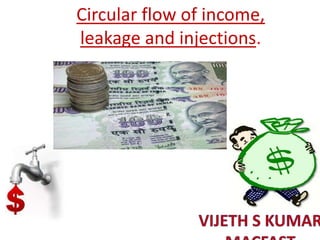
Economics(circular flow)
- 1. Circular flow of income, leakage and injections.
- 2. Circular flow of income????? • The term circular flow of income or circular flow of economic activity refers to “a simple economic model which describes the circulation/flow of income between producers and consumers”. • In the circular flow model, producer and consumer are referred to as "firms" and "households" respectively.
- 3. Significance of Study of Circular Flow of Income Measurement of National Income- National income is an estimation of aggregation of any of economic activity of the circular flow. It is either the income of all the factors of production or the expenditure of various sectors of economy. Knowledge of Interdependence- Circular flow of income signifies the interdependence of each of activity upon one another Unending Nature of Economic Activities- It signifies that production, income and expenditure are of unending nature, therefore, economic activities in an economy can never come to a halt. National income is also bound to rise in future. To understand about the leakages in economy and injections
- 4. Foreign Household sector Determinants Firms/ business Financial institutions
- 5. HOUSE HOLD
- 6. Households: It is a person or a group of people that share their income. The members of households have two functions: they supply different factors of production members of household also work as consumers
- 7. FIRMS
- 8. Firms: An organization that produces goods and services for sale. main objective is to maximize profit in the production process. The two main functions are as follows: Produce goods and services and supply them in the market. Firms purchase inputs or raw materials from households to use them in the production process
- 9. GOVERNMENT
- 10. Government Just like households and firms the government also earns incomes and makes expenses. Two major functions played are: Government earns revenue either from tax or non-tax sources both from households and firms. Government provides essential public services such as maintenance of law and order, defence services, judiciary etc.
- 12. Financial institutions Financial Institution : consists of banks and non-bank intermediaries who engage in the borrowing (savings from households)and lending of money. the leakage that financial institutions provide in the economy is the option for households to save their money.
- 13. Foreign sector
- 14. Foreign Market: It consists of two kinds of international economic transactions i.e. export and import of goods and services inflow and outflow of capital.
- 15. Have a glance on Two sector model Three sector model Four sector model Five sector model
- 16. TWO SECTOR MODEL
- 22. Three sector model Three sector model is created by adding the Government sector to the Two sector model Three kinds of monetary flows between the government and the rest of the economy i.e.1)direct taxes on both households and firms2)government expenditure3)transfer payments and subsidies Government spends a part of its tax revenue as factor payments to the households and a part in the form of transfer payments as pension and food subsidy etc.
- 24. Govt borrowings
- 26. This circular flow of model shows the four macro economic sectors of the economy i.e. household, business firm, government, and financial institutions. These four sectors capture four fundamental macroeconomic functions and their expenditures are combined together to purchase the economy's total production.
- 27. To introduce the financial market, it is assumed that household saves in the financial market. There are no inter-households borrowing If the households save a part of their income in the financial market (such as banks, insurance companies, stock market etc), this reduces the expenditure of household on goods and services Ultimately it reduces the flow of money/income of the economy. So saving known as the leakage of the economy
- 30. Foreign Market(export and import): Goods and services produced within the domestic territory which are sold to the foreigners are called exports. Purchases of foreign made goods and services by domestic households are called as imports. Here we assume that only business forms can interact with the foreign countries and dealt with the export and import of the country. Money goes through import from the economy again return back to the country through export activities.
- 32. Leakage Injection Savings Investments Taxes Govt. spending Imports Exports
- 33. Why savings become a leakage?????? In terms of the circular flow of income model the leakage that financial institutions provides an option for households to save their money. This is a leakage because the saved money can not be spent in the economy and thus it is an idle asset, that means no output will be purchased. The injection that the financial sector provides into the economy is investment (I) into the business/firms sector.
- 34. How tax becomes a leakage????? Tax is paid to Government by households and firms Tax is a leakage because it is a leakage out of the current income and reduces the expenditure on current goods and services The injection provided by Government on this leakage is Government spending( services and welfare payments to the community) For e.g.. Income tax collected by Govt is a leakage and Govt spends some amount as food subsidy as an injection.
- 35. How Imports becomes a leakage????? Imports are leakage because it is the spending by residents into the rest of the world. It becomes a leakage because the money in the home market goes to countries abroad. The main injection provided by this sector is the exports of goods and services which generate income for the exporters from overseas residents.
- 36. In five sector circular flow of income model, the state of equilibrium occurs when the total leakages are equal to the total injections that occur in the economy. This can be shown as: Savings + Taxes + Imports = Investment + Government Spending + Exports S + T + M = I + G + X.